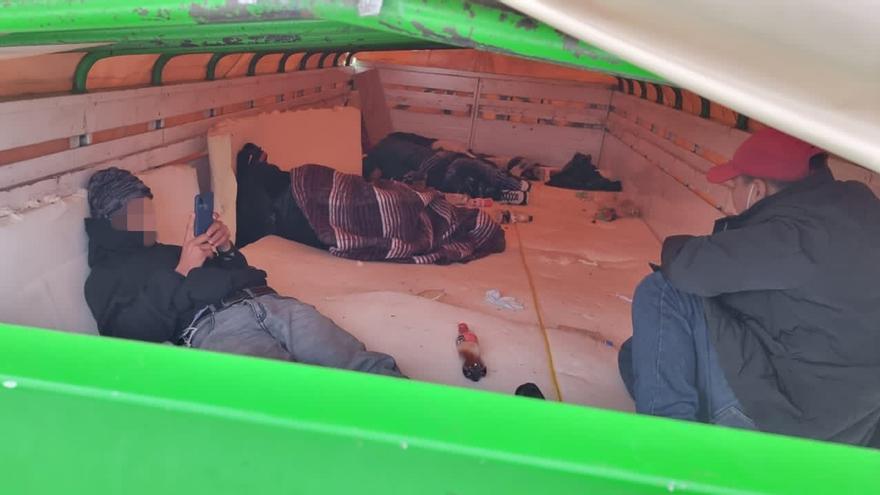
![]() 14ymedio, Ángel Salinas, Mexico, 11 February 2022 – – The Minister of Public Security (SSP) of the Mexican state of San Luis Potosí is investigating a trafficking network that charges $8,000 to $10,000 to take migrants to the U.S. border. Between last Wednesday and Thursday, 135 foreigners, 22 of them Cuban, were detained as part of the first investigations.
14ymedio, Ángel Salinas, Mexico, 11 February 2022 – – The Minister of Public Security (SSP) of the Mexican state of San Luis Potosí is investigating a trafficking network that charges $8,000 to $10,000 to take migrants to the U.S. border. Between last Wednesday and Thursday, 135 foreigners, 22 of them Cuban, were detained as part of the first investigations.
“It’s a criminal group that is making transfers due to gaps in security to avoid the National Guard checkpoints,” state security spokesman Miguel Gallegos Cepeda tells 14ymedio. Coyotes arrive in the villages and pass migrants off as tourists to avoid suspicion.
Traveling from San Luis Potosí last Wednesday, in the community of Villa Hidalgo, the police located five vehicles that were hiding behind an embankment, so they requested the support of the Army and the National Guard in the face of a possible “narcotics” event. According to SSP information, the drivers accelerated to try to flee but were intercepted by the military.
Six coyotes were traveling in the five vehicles, all from the state of Puebla, and they were transporting 30 migrants: 15 Cubans, including a family with children, 10 Nicaraguans, and 5 Guatemalans. The drivers were arrested and transferred to the facilities of the Attorney General’s Office, where an investigation was opened for the trafficking of migrants.
“Caravans with dozens of Central Americans are passing through the state. Now there are many Haitians who are trying to find work, but these transfers in vans and trucks are from a network that is beginning to exploit the so-called Gulf route,” Antonio, an agent of the Prosecutor’s Office, told this newspaper.
From San Luis Potosí, explains the official, there are two options to reach the border with the U.S. The first is to go to Monterrey and from there to Nuevo Laredo, on the Tamaulipas border with U.S. territory, and the second is to leave for Saltillo, in the border state of Coahuila, and from there to Piedras Negras to try to reach Eagle Pass, in Texas.
The first inquiries located a group operating in the vicinity of the Palenque archaeological zone, in Chiapas. “Part of this network takes migrants to Coatzacoalcos, in Veracruz, then through the municipality of Tierra Blanca until they reach Orizaba, and from there they leave for Querétaro and continue until they reach San Luis Potosí,” Antonio emphasizes.
“The $10,000 dollar charge is not [only] for the transfer through Mexico but from the countries of origin. We hope to finish putting together the puzzle and dismantle this group,” explains the agent.
Last Thursday, state police detected a truck that was speeding in the Potosi municipality of Charcas. After a chase the driver was arrested in the stretch that connects the community of Matehuala with El Huizache. The back of the truck had two levels and was lined with spongy material, and 105 migrants were found there: 28 from Guatemala, 21 from Honduras, 13 from El Salvador, 36 from Nicaragua, and 7 from Cuba.
“This confirmed the modus operandi of the trafficking network. Migrants mentioned that they paid $10,000 to reach the U.S. The coyotes sold them the idea of up to three transfer opportunities in case they were arrested and returned to Guatemala.”
So far they have detained 7 people in the human trafficking network, and investigations are continuing concerning the owners of the secured vehicles.
Meanwhile, in the Yucatán, the Mexican Navy rescued 8 Cuban rafters who were found 12 nautical miles from Puerto Progresso. After being attended to by medical personnel, they were transferred to the remote terminal of Progresso and taken to the National Migration Institute.
Translated by Regina Anavy
____________
COLLABORATE WITH OUR WORK: The 14ymedio team is committed to practicing serious journalism that reflects Cuba’s reality in all its depth. Thank you for joining us on this long journey. We invite you to continue supporting us by becoming a member of 14ymedio now. Together we can continue transforming journalism in Cuba.
